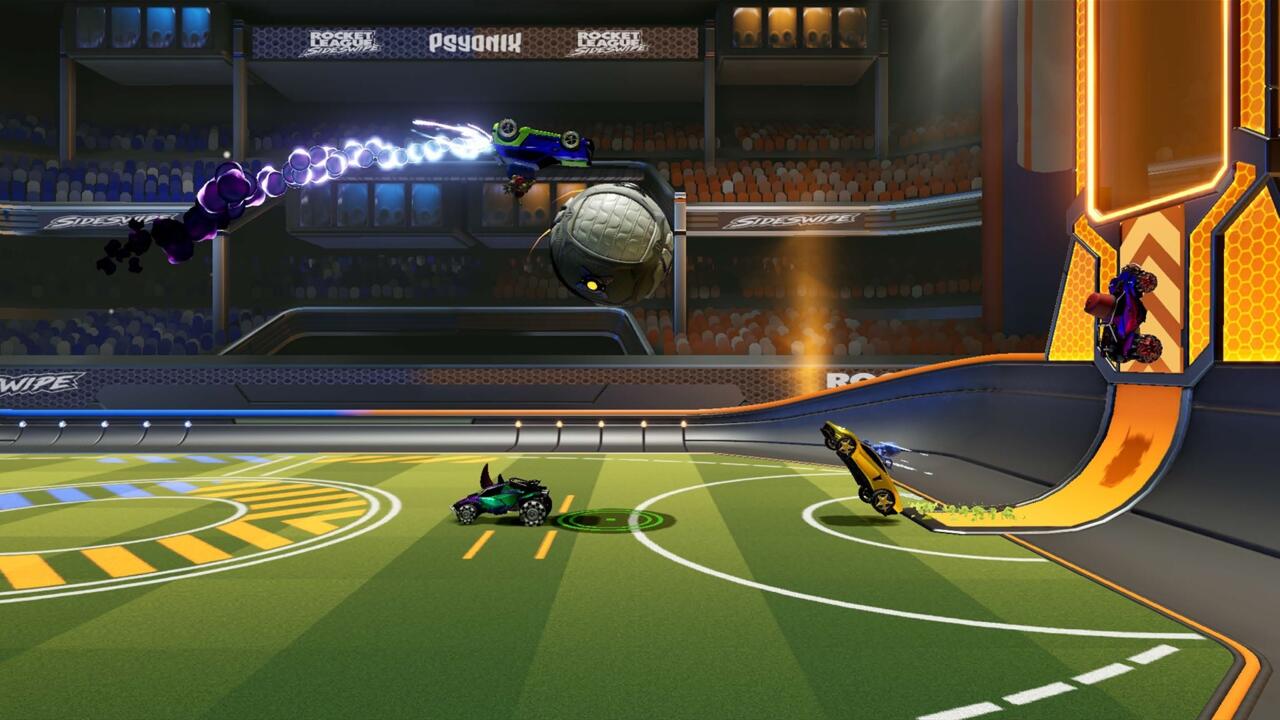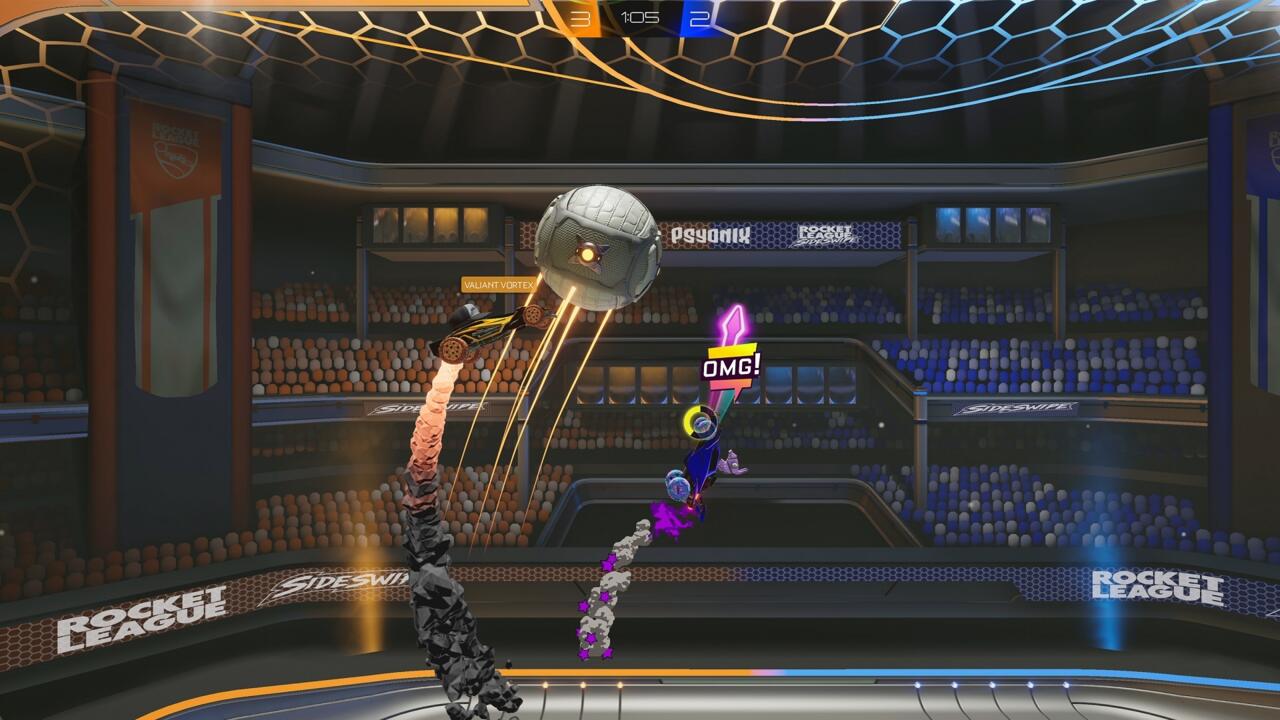Rocket League is a perfect combination of calculated action and unexpected chaos. The idea of playing soccer with cars is itself a good one, but it's the way that Rocket League feels that makes it so much fun to play. Ludicrous speed, perfectly controlled cars, and goofy, floaty physics interactions turn every play into a melding of intelligent execution and unpredictable luck. Any version of Rocket League on a mobile device would have to capture that same feeling, and it's remarkable how much Rocket League Sideswipe--a scaled-down, super-quick mobile take on the Rocket League concept--captures exactly what makes its full-sized counterpart so enjoyable.
Sideswipe succeeds in creating a conception of Rocket League that caters to mobile play. This is a platform where time is spent in short bursts and where the best games are those that find a sweet spot between solid control and decreased complexity. For developer Psyonix, that sweet spot is found by taking the fundamentals of Rocket League and flattening them into a 2D version of the 3D game. This is still soccer with cars (or basketball with cars, depending on the playlist you choose), but instead of covering a whole 3D soccer field, you instead only have to deal with all the action on a single plane.

The side-on view of the field means that a few elements of Rocket League work differently in the mobile version. You can't crash into other cars, for instance--only the ball, the floors, and the wall affect your vehicle in motion. And since goals can't be horizontal, they instead extend vertically into the air with a lip at top and bottom, requiring you to give your shots a little lift in order to score.
Though playing a two-dimensional version of Rocket League sounds like it could rob the game of the fundamentals of its skill-based play, the reality is that flattening the game works perfectly. In the 3D game, Rocket League is about controlling the space, using rocket boosters to chase the ball in the air and find unexpected angles of attack. But the verticality of the 2D field maintains a lot of this same feeling, thanks in large part to the way the controls have translated between the bigger game and its smaller incarnation. Cars handle pretty much exactly the way they do in the original Rocket League, with powered dodge maneuvers giving you a little extra momentum or providing the feeling of a "kick," and rocket boosters that can speed you into position or send you through the air. The 2D approach and vertical goal means that most of Sideswipe is airborne, and the floaty physics of Rocket League translate exceptionally well to this approach.
Rocket League is largely about getting good at the way you can make your car fly and how it handles in the air, and the same is true of Sideswipe. The skill and challenge of the game comes in getting your small car into the right spot to stop a big shot or tap in a goal. Because the 2D space maintains that focus on flying, Sideswipe still feels great in a lot of the same ways as the larger game. Though this version of the competition is simplified, the key elements of learning the peculiarities of making cars fly, anticipating the game's physics, and making huge plays come through perfectly.
What makes it all work is how responsive Sideswipe's controls are. Psyonix has done a phenomenal job of bringing the fast pace and airborne nature of Rocket League to a 2D space, a small screen, and touch controls. Sideswipe packs three buttons--the equivalent of an analog control stick for directing your car's nose (and thus determining where you drive or how it flies), a button to jump that you can double-tap to activate the flipping dodge move, and a booster button that activates your rockets. Again, simplicity is on the game's side here, because you're really only tapping one button and using your other thumb to direct your car.

The 2D presentation and touch controls work exceedingly well together. The size of the field relative to your car means that there's lots of space to put your thumbs without feeling like you're covering the action, and since you're only determining where your car is pointing on X and Y axes, the thumbstick touch control is just about pointing yourself where you want to go. Everything feels tight and responsive despite the lack of physical buttons, and because things are relatively simple, you won't find yourself losing track of the positions of the controls on screen without the benefit of feeling them.
Still, Sideswipe is at its best when you connect a controller to your mobile device. As good as the touch controls are, there's a serious benefit to the tactile feedback of directing an actual thumbstick or pressing a physical button. As is the case with all touch control games, you'll eventually move your thumb too far in one direction or another and need to reposition for proper control. The limits of touch controls create something of a skill ceiling that the benefits of a controller make it possible to surpass.
Sideswipe currently includes three game modes, all of which are ranked: Duels, Duos, and Hoops. The first two are standard one-on-one or two-on-two matches, respectively, with the fields adjusted slightly to make scoring a bit easier when you don't have a teammate backing you up in a Duels match. Hoops brings in the Rocket League alternate mode of basketball with cars, requiring you to drop the ball into a goal from above. It plays just differently enough to offer a little variety to the game experience. When you search for games, you can choose which of the three playlists are included, allowing you to just go after a certain kind of experience, or mix all of them together. Each variation is just enough of an alteration to the formula to keep things fresh and interesting, without overstaying its welcome thanks to the fact that matches only last two minutes at a time.
At the moment, Sideswipe is a free-to-play game with no means of monetization, although the bones of systems where you could pay into the game are present. Completing matches, win or lose, earns you experience points, which earn you in-game currency and unlock cosmetic rewards along a battle pass-like reward track. There are also a series of "challenges" you can complete that give XP bonuses--things like "win three Duels" matches or "play five matches with this particular car body." None are particularly difficult, but they do give you a little something more to focus on as you play. The progression system also clips right along, dishing out lots of little rewards along the way that give you some incentive to play other than increasing your rank in each of the activities. One assumes the game will adopt some sort of monetization structure in the future, and it'll probably be similar to that of the original Rocket League's paid Rocket Pass structure, but we'll have to wait to see how that might affect the game.
Right now, though, Rocket League Sideswipe is a blast. It's a downsized version of Rocket League that streamlines and shrinks the experience, without sacrificing its fundamental nature. It also brilliantly takes advantage of the mobile medium with super-quick games, easy-to-understand mechanics, and excellent controls. Sideswipe is a smaller, quicker, lighter-weight version of Rocket League that still captures why the original is so endearing, and it's absolutely a game you should make space for on your phone.













